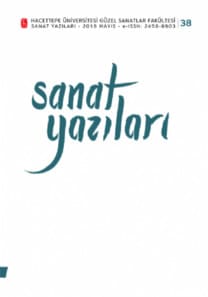(POST) MODERN BİR MİT OLARAK IZGARA: EISENMAN’IN KAVRAMSAL MİMARLIĞININ BAŞI VE SONU
Bu yazıda Peter Eisenman'ın daha ismi bile yok iken başlattığı mimari yapısökümün kendisinin mitsel bir yapıya sahip olduğu savunulmuş ve mimarın mitsellikle olan ilişkisini nasıl gözden geçirdiği açıklanmaya çalışılmıştır. Eisenman henüz tam anlamıyla gerçekleşmemiş olduğuna inandığı Modernizme taze bir yol açmak için yeni bir tarihsel kırılma arayışını kariyerinin başlıca amacı haline getirmişti. Eisenman'ın tarihselciliği çözmek için kullandığı yöntem, biçim ve anlam arasında kurulmuş olan tarihsel ilişkileri "mitsel" kabul etmekti. Farklı zamanlarda Yapısalcılık, avangard sanat, Kavramsal Sanat, psikanaliz ve Yapısöküm gibi farklı etkilere maruz kalan kuramsal gelişiminde hiç kaybolmayan ama giderek belirginleşen bir şey, ızgara, uzun kariyeri boyunca mimarın sentetik ve eklektik kuramından kaynaklanan çelişkileri çözmek için kullandığı başlıca araç olmuştur. Başlangıçta mimarlıkta rasyonellik mitosunu sağlayan ızgara gerekmedikçe ortaya çıkmayan soyut bir yapı iken, daha sonra Eisenman'ın, kendi mimarlığının mitselliğinin varlığını ve yokluğunu aynı anda ima eden ve üslupsal diyebileceğimiz bir temaya dönüşmüştür
GRID AS A (POST) MODERN MYTH: THE BEGINNING AND THE END OF EISENMAN’S CONCEPTUAL ARCHITECTURE
In this study, it is claimed that the architectural deconstruction, started by Peter Eisenman when the term did not yet exist, was itself mythical; it also tries to demonstrate how the architect reviewed his relationship with mythicality. Peter Eisenman made the fundamental purpose of his career to create a new historical break in architecture in order to clear a fresh route for Modernism. Eisenman’s method for deconstructing historicism was to regard the historical connections between form and meaning as “mythical”. One thing, the grid, which became even more perceivable instead of disappearing in his theoretical evolution that was subjected to various effects at various times, such as Structuralism, avant-garde art, Conceptual Art, psychoanalysis and Deconstruction, has always been his main tool to solve the contradictions resulting from his synthetic and eclectic theoretical approach. Initially, the grid was an abstract structure which provided the myth of rationality. Later on, it became a theme which we may call stylistic, implying at the same time the presence and absence of the mythicality of his architecture
___
Ansari, Iman. (2013). Eisenman’s Evolution: Architecture, Syntax, and New Subjectivity. Erişim: 24.08.2016. http://www.archdaily.com/429925/eisenman-s-evolution-architecture-syntax-and-new-subjectivityBoccioni, Umberto. (2009a). The Plastic Foundations of Futurist Sculpture and Painting (1913). Lawrence Rainey vd. (Haz.). Futurism: An Anthology, s. 139-142. New Haven: Yale University Press.
Boccioni, Umberto. (2009b). Absolute Motion+Relative Motion=Dynamism (1914). Lawrence Rainey vd. (Haz.). Futurism: An Anthology, s. 187-194. New Haven: Yale University Press.
Brillembourg, Carlos. (2011). Peter Eisenman by Carlos Brillembourg. BOMB Magazine, 117. Erişim: 24.08.2016. goo.gl/153jqZ
Chomsky, Noam. (1965). Aspects of the Theory of Syntax. Cambridge: The MIT Press.
Civelek, Yusuf. (2015). Manifestoların Perspektifinden: Antonio Sant’Elia Fütürist mi? Megaron, 10/4, s. 522-535.
Derrida, Jacques. (1990). A Letter to Peter Eisenman. Assemblage, 12, s. 6-13.
Durand, Jean-Nicolas-Louis. (1802). Précis des leçons d’architecture données à l’école polytechnique (1. Cilt). Paris: Ecole Polytechnique.
Durand, Jean-Nicolas-Louis. (1817). Précis des leçons d’architecture données à l’école royale polytechnique (1. Cilt). Paris: Firmin Didot.
Eisenman, Peter. (2006). The Formal Basis of Modern Architecture. Zürih: Lars Müller Publishers.
Eisenman, Peter. (1996). Post-Functionalism. Kate Nesbitt (Haz.). Theorizing A New Agenda for Architecture, s. 236-239. New York: Princeton Architectural Press.
Eisenman, Peter. (1984). The End of the Classical: The End of the Beginning, the End of the End. Perspecta, 21, s. 154-173.
Eisenman, Peter (1975). House I 1967. Peter Eisenman (Haz.). Five Architects, s. 15-25. New York: Oxford University Press.
Eisenman, Peter. (1970). Notes on Conceptual Architecture: Towards a Definition. Design Quarterly, 78/79, s. 1-5.
Frampton, Kenneth. (1975). Frontality vs Rotation. Peter Eisenman (Haz.). Five Architects, s. 9-13. New York: Oxford University Press.
Gandelsonas, Mario. (1998). Linguistics in Architecture. K. Michael Hays (Haz.). Architectural Theory since 1968, s. 112-123.. Cambridge: The MIT Press.
Kaufmann, Emil (2002). De Ledoux à Le Corbusier: Origine et développement de l’architecture autonome. Paris: Editions de La Villette.
Krauss, Rosalind E. (1979). Grids. October, 9, s. 50-64.
Krauss, Rosalind E. (1977a). Passages in Modern Sculpture. New York: The Viking Press.
Krauss, Rosalind E. (1977b). Notes on the Index: Seventies Art in America. October, 3, s. 68-81.
Lévi-Strauss, Claude. (1995). Myth and Meaning. New York: Schocken Books.
Lévi-Strauss, Claude. (1955). The Structural Study of Myth. The Journal of American Folklore, 68/270, s. 428-444.
Luscombe, Desley. (2014). Architectural Concepts in Peter Eisenman’s Axonometric Drawings of House VI. The Journal of Architecture, 19/4, s. 560-611.
Macarthur, John. 1993. Experiencing Absence: Eisenman and Derrida, Benjamin and Schwitters. John Macarthur, (Haz.). Knowledge and/or/of Experience, s. 99-123. Brisbane: Institute of Modern Art.
Mastrigli, Gabriele ve Toti, Alessandro. (2014). Operative Differences: Eisenman, Tafuri and the Lesson of Piranesi. SAJ, 6, s. 238-255.
Rowe, Colin ve Slutzky, Robert. (1963). Transparency: Literal and Phenomenal. Perspecta, 8, s. 45-54.
Rowe, Colin. (1975). Introduction. Peter Eisenman (Haz.). Five Architects, s. 3-7. New York: Oxford University Press.
Rowe, Colin. (1976). Mathematics of the Ideal Villa and Other Essays. Cambridge: The MIT Press.
Sennett, Richard. (1999). Gözün Vicdanı: Kentin Tasarımı ve Toplumsal Yaşam (S. Sertabiboğlu, C. Kurultay Çev.). İstanbul: Ayrıntı Yayınları.
Taylor, Mark C. (1992). Disfiguring: Art, Architecture, Religion. Chicago: The University of Chicago Press.
Vidler, Anthony. (1999). Architectural Uncanny: Essays in the Modern Unhomely. Cambridge (Mass.): The MIT Press.
Vidler, Anthony. (2012). Palladio Reassessed by Eisenman. The Architectural Review. Erişim: 24.08.2016 goo.gl/bR2A35
Wittkower, Rudolf. (1949). Architectural Principles in the Age of Humanism. London: Warburg Institute.
- ISSN: 2458-8903
- Yayın Aralığı: Yılda 2 Sayı
- Başlangıç: 2001
- Yayıncı: -
Sayıdaki Diğer Makaleler
BİLİM, MAKİNE VE SANAT: KESİŞMELER-ÇATIŞMALAR
SERAMİK SANATINDA BRÜTALİST ETKİ
GÖRÜNEN TARAFIN GÖRÜNMEYENİ (CORNELİS NORBERTUS ‘‘RESMİN TERS TARAFI’’ ESERİ ÜZERİNE)
(POST) MODERN BİR MİT OLARAK IZGARA: EISENMAN’IN KAVRAMSAL MİMARLIĞININ BAŞI VE SONU
ARMAN T. MANOOKİAN: KAYIP CENNETİN İMGESİ
SÜRDÜRÜLEBİLİR KAMPÜS YAKLAŞIMLARI VE TÜRKİYE’DEKİ GELİŞMELER
20. YÜZYIL SANATINDA GÜNDELİK HAYAT – SANAT İLİŞKİSİ
